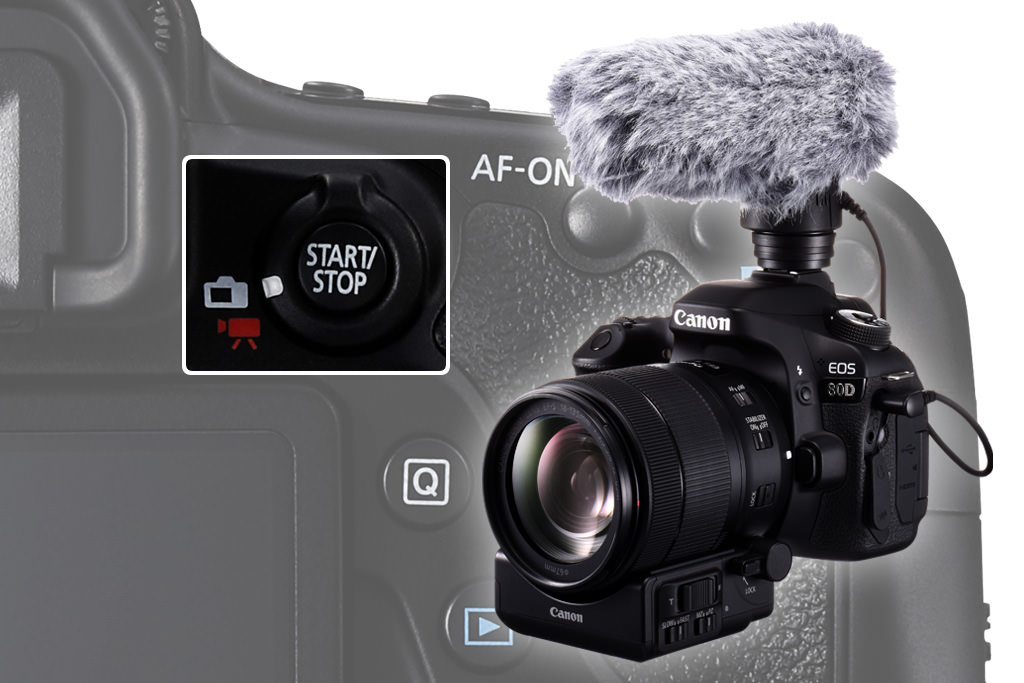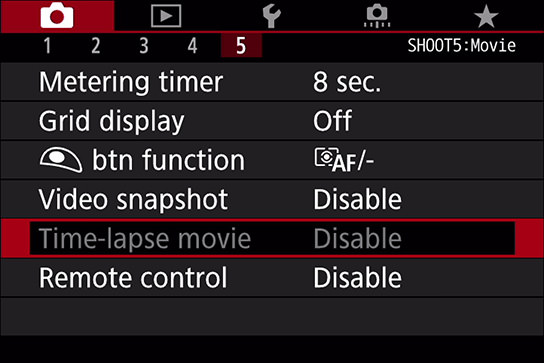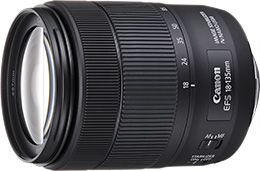Besides its function as a DSLR camera, the EOS 80D is also a high-performance movie camera that is capable of capturing fascinating movies. In the following, let us take a look at how we can widen our range of photographic expression with the smooth AF and accessories. (Photo & text by: Ryosuke Takahashi)

Making professional movies with Dual Pixel CMOS AF
DSLR movies in the past had to rely on manual focusing, and users needed to incorporate different creative efforts and techniques in order to produce images close to what we see on TVs. However, the EOS 70D simplified such processes such that anyone can now produce professional movies simply by turning the switch to the Movie mode. The EOS 80D has enhanced this further, being packed with a multitude of movie-related features, many of which were developed with both still photography and movie shooting in mind.
One such feature is Dual Pixel CMOS AF, which allows for speedy focusing when taking a still shot, while enabling smooth focusing while changing the AF speed when you are shooting a movie.
The steps for shooting a movie are simple and almost identical to capturing still shots using the Live View function. Simply set the Mode Dial to Program AE and the camera will automatically determine the respective settings in the same way as Scene Intelligent Auto for still shooting. You are recommended to make use of the superb image quality of EOS Movie to capture scenes that can only be expressed with movies.
For even more shooting options, there is also a rich variety of interchangeable lenses suitable for movie shooting and an abundant variety of accessories designed specially to support the shooting work.
For more about Dual Pixel CMOS AF and the improvements to AF on the EOS 80D, read:
EOS 80D Interview with Developers (Part 1): Major Improvements to AF Performance
Also check out the following article about the EOS 80D’s subject tracking performance during movie shooting:
EOS 80D Test Shoot Review: Subject Tracking Performance during Movie Shooting
Before you shoot
1. Change settings with the Quick Control button

As with Live View shooting, you can change the settings using the Quick Control button. How it differs from still shooting is that the video size and frame rate will be fixed once you have selected a movie recording size.
2. Use a large-capacity recording media

As the file size of movies is large, you are recommended to prepare a large-capacity recording media if you are planning for a long shoot. It would be convenient to have a UHS Speed Class 3 card (or above) that is able to write and read data at a high speed.
3. Get ready a tripod for greater convenience

One of the tips for capturing clear movies is to prevent camera shake that might cause the images to turn out blurry. If you are recording a landscape together with moving objects such as birds, mount the camera on a tripod to prevent the background from turning out blurry.
4. Use the Power Zoom Adapter PZ-E1 to enhance zooming smoothness
Zooming is one of the key techniques used to create various effects in movies, Turning the zoom ring at a constant speed creates a natural flow, whereas zooming in and out smoothly helps to bring out the best in the subject and the scene.
Using the Power Zoom Adapter PZ-E1 in combination with the EF-S18-135mm f/3.5-5.6 IS USM lens (also suited for movie shooting; more about the lens here) enables motorised control of the zoom ring and smooth adjustment of the angle of view. It is easy to handle even during handheld shooting, and allows you to control the speed of zooming. You can therefore adjust it according to the ambience of the location, such as by slowing down the zoom speed when shooting a scene with a relaxed atmosphere.
For some answers to common questions about the Power Zoom Adapter PZ-E1, refer to:
More About the EOS 80D (Part 1) – Body
EOS 80D Interview with Developers (Part 3): Enhanced Wi-Fi and Movie Features
For an actual-use review of the EOS 80D and EF-S18-135mm f/3.5-5.6 IS USM lens pairing, check out:
EOS 80D Lens Pairing Review: EF-S18-135mm f/3.5-5.6 IS USM

The Power Zoom Adapter PZ-E1 attached to the EOS 80D together with a special external microphone. Although it comes in a compact palm size, the unit is extremely useful and is a must-have item for shooting movies.

Here, I was zooming in on a seagull from a distant position. With the EF-S18-135mm f/3.5-5.6 IS USM, I was able to capture a close-up view of the subject despite the distance. Also, the camera is able to function almost silently, and is therefore suited for capturing animals.
EOS Movie feature (1): 5 types of Creative filters for movie shooting
The Movie shooting mode on the EOS 80D allows you to produce images that are similar in style to still shots applied with Creative filter effects. While the actual effects are not exactly the same as those for stills, they do allow you to produce video images that leave a stronger impression.
There are five different types of Creative filters for movie shooting, each of which is different in colour and movement. Note that you would not be able to select a movie recording size with a high frame rate, but apart from that, the shooting process is the same as for movies with no effects.
Memory: Creates vignetting in the peripheral areas while keeping the saturation of the image subdued to convey an impression that is reminiscent of a distant memory.
Dream: A white gradation is applied to the four corners of the image to create a fantastical atmosphere. It is useful for producing a soft depiction of subjects such as a human portrait or flower.
Old Movies: Flickering and scratch effects are added to the image to create a feel that is similar to that of an old movie. This effect brings out the ambience especially when you are shooting movies of landscapes.
Dramatic B&W: Monochrome movies with a high contrast. Images are reproduced in greyscale, making it suitable for conveying a more intense impression.
Miniature effect movie: In addition to a significant amount of blur in front and at the back of the subject, time is also compressed which makes the movement of the subject appear jerky. Audio sound is not recorded with this effect.
EOS Movie feature (2): Time-lapse movies
Recording a landscape with the time-lapse movie feature allows the reproduction of cloud movement at a high speed, creating an effect similar to a typhoon coming.

Time-lapse movie is a feature that connects a vast number of still shots into a single movie that depicts changes in the subject or brightness over time. To use this feature, you first need to determine the shooting interval and number of shots to take before starting. The recording time required and playback time are also displayed, which eases planning of the shoot. To shoot time-lapse movies on the EOS 80D, go to [Time-lapse movie] on the SHOOT5 menu and change it from [Disable] to [Enable].
EOS Movie feature (3): High-contrast scenes suited for HDR movies

As with the HDR Mode – Natural, HDR Movie Shooting is a mode for shooting movies with the contrast reduced, and is thus suited for scenes where there are strong shadows or when you want to record both indoor and outdoor scenes at the same time. This feature comes in handy when the level of contrast is too high and beyond the control of the Auto Lighting Optimizer. As illustrated in the diagram below, two frames with different exposures are merged for a natural result.

The underlying principle for merging is similar to that of the HDR shooting feature for still images. As the process takes place inside the camera, the standard exposure and underexposure images are not recorded to the SD card.
A: Standard Exposure
B: Underexposure
C: Merged in-camera
D: HDR Movie
Receive the latest updates on photography news, tips and tricks by signing up with us!
About the Author
A monthly magazine that believes that enjoyment of photography will increase the more one learns about camera functions. It delivers news on the latest cameras and features and regularly introduces various photography techniques.
Published by Impress Corporation
Born in Aichi in 1960, Takahashi started his freelance career in 1987 after working with an advertising photo studio and a publishing house. Besides photographing for advertisements and magazines in and out of Japan, he has also been a reviewer for “Digital Camera Magazine” since the launch of the publication as well as published a number of works. In his product and lens reviews, Takahashi particularly advocates photography techniques that bring out the lens performance through his unique point of view and tests. Takahashi is a member of the Japan Professional Photographers Society (JPS).


































